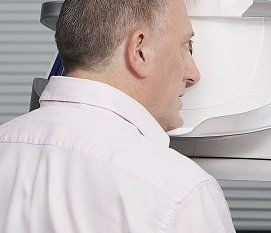Optomap is a method of taking a comprehensive digital image of the retina, the light-sensitive tissue in the back of the eye, during an eye exam. There is no need for dilating eye drops because it is a painless, non-invasive treatment that gives a thorough picture of the retina.
By creating a panoramic image of the retina through the use of scanning laser ophthalmoscopy, the Optomap technology enables opticians to detect early indicators of eye disorders such as macular degeneration and diabetic retinopathy. Optomap makes high-resolution images that can be saved and compared in the future. This makes it easier for eye doctors to keep track of changes in the retina over time.
Because the Optomap technology offers a larger picture of the retina than conventional eye exams, it is very helpful in the detection and management of eye problems. This broader perspective enables eye specialists to spot possible problem areas that would not be noticeable during conventional eye exams, aiding in the early and more efficient diagnosis and treatment of eye conditions.
Pros
Optomap retinal imaging captures more than 80% of the retina, making it ideal for a thorough eye exam. This provides early diagnosis of vision deterioration or blindness. In addition to allowing for the early detection of serious eye conditions including blindness, macular degeneration, and diabetic retinopathy, optomap tests are helpful because they offer more in-depth imaging and insights than standard pupil dilation.

Also, unlike traditional eye exams, optomap scans don't necessitate dilatation, which can cause temporary blurriness and sensitivity to light. However, optomap tests could be more expensive than standard eye exams, so it's crucial to ask your doctor about their charges.
Cons
Optomap ultra-widefield retinal imaging has several drawbacks, and it might not be as reliable as conventional pupil dilation in spotting some conditions. Also, it is a special technique that catches more than 80% of the retina in a single scan; however, it might not be appropriate for all patients.
FAQ's
Is optomap worth it?
Whether optomap is worthwhile depends on the specific circumstances and requirements of each individual. Optomap ultra-widefield retinal imaging has several advantages, such as enhancing the diagnostic capabilities of an eye exam and allowing for the early diagnosis of retinal illness. It may not be as precise as conventional pupil dilation in identifying some conditions, though, and has some limitations. It is advisable to speak with an ophthalmologist to establish if an optomap is the best option for a person's specific needs.
Why is optomap not covered by insurance?
Optomap is not covered by vision insurance, however, depending on the terms of the policy, it may be covered by medical insurance. And yet many people may still have trouble getting optomap imaging because their insurance doesn't cover it. Before delivering the test, it is advisable to discuss payment and financial responsibilities with the patient. Certain eye clinics may demand optomap retinal scanning even if insurance does not cover it, although this is dependent on particular circumstances.
Are there any side effects associated with optomap?
Optomap imaging has not been linked to any negative effects. The Optomap method is non-invasive, painless, and doesn't involve any contact with the eye. Optomap does not result in temporary visual blurriness or light sensitivity, unlike conventional eye tests that demand dilating eye drops.
What is the difference between optomap vs dilation?
The way the retina is examined is the primary distinction between optomap and dilatation. Whereas dilatation necessitates the use of drops to expand the pupils in order to examine the retina, optomap enables the physician to capture a 200-degree image of the retina in a single shot without any adverse reactions. Optomap takes only a few minutes from start to finish and offers an expanded image that enables a more in-depth look at the retina. Optomap, on the other hand, has a few shortcomings and cannot completely substitute for dilation.
Does optomap use radiation?
Optomap is completely radiation-free. It is vital for the early identification of a wide range of eye disorders, including glaucoma, vision problems, and diabetic retinal impairment, and it operates on the basis of light.
What is the average cost of an optomap?
Optomap prices vary according to location and eye clinic. Some reports state that you should expect to pay between $39 to $65 for optomap imaging. When optomap images are saved for future use, certain eye clinics may impose an additional payment. For information on precise pricing, it is better to contact individual eye clinics.






0 Comments
For comments please reply here.......